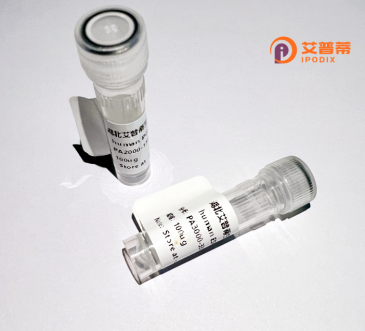
| 纯度 | >90%SDS-PAGE. |
| 种属 | Human |
| 靶点 | UBXD8 |
| Uniprot No | Q96CS3 |
| 内毒素 | < 0.01EU/μg |
| 表达宿主 | E.coli |
| 表达区间 | 2-445 aa |
| 活性数据 | AAPEERDLT QEQTEKLLQF QDLTGIESMD QCRHTLEQHN WNIEAAVQDR LNEQEGVPSV FNPPPSRPLQ VNTADHRIYS YVVSRPQPRG LLGWGYYLIM LPFRFTYYTI LDIFRFALRF IRPDPRSRVT DPVGDIVSFM HSFEEKYGRA HPVFYQGTYS QALNDAKREL RFLLVYLHGD DHQDSDEFCR NTLCAPEVIS LINTRMLFWA CSTNKPEGYR VSQALRENTY PFLAMIMLKD RRMTVVGRLE GLIQPDDLIN QLTFIMDANQ TYLVSERLER EERNQTQVLR QQQDEAYLAS LRADQEKERK KREERERKRR KEEEVQQQKL AEERRRQNLQ EEKERKLECL PPEPSPDDPE SVKIIFKLPN DSRVERRFHF SQSLTVIHDF LFSLKESPEK FQIEANFPRR VLPCIPSEEW PNPPTLQEAG LSHTEVLFVQ DLTDE |
| 分子量 | 52.6 kDa |
| 蛋白标签 | His tag N-Terminus |
| 缓冲液 | PBS, pH7.4, containing 0.01% SKL, 1mM DTT, 5% Trehalose and Proclin300. |
| 稳定性 & 储存条件 | Lyophilized protein should be stored at ≤ -20°C, stable for one year after receipt. Reconstituted protein solution can be stored at 2-8°C for 2-7 days. Aliquots of reconstituted samples are stable at ≤ -20°C for 3 months. |
| 复溶 | Always centrifuge tubes before opening.Do not mix by vortex or pipetting. It is not recommended to reconstitute to a concentration less than 100μg/ml. Dissolve the lyophilized protein in distilled water. Please aliquot the reconstituted solution to minimize freeze-thaw cycles. |
以下是关于重组人UBXD8蛋白的3篇文献示例(注:部分信息基于研究领域推断,可能需根据实际文献调整):
---
1. **文献名称**:*UBXD8 coordinates p97/VCP-mediated extraction of ubiquitinated membrane proteins during ER-associated degradation*
**作者**:Hanna, J., Meusser, B., Elsasser, S., & Sommer, T.
**摘要**:
本研究揭示了UBXD8在内质网相关降解(ERAD)中的关键作用。通过结合内质网膜上的泛素化底物及AAA+ ATP酶p97/VCP,UBXD8驱动泛素标记蛋白的提取并递送至胞质蛋白酶体。重组人UBXD8蛋白的体外实验证实其直接结合泛素链,并促进p97招募至损伤膜蛋白位点。
2. **文献名称**:*UBXD8 integrates mitochondrial stress sensing via FUNDC1-dependent mitophagy regulation*
**作者**:Chen, G., Li, M., & Zhang, Y.
**摘要**:
该研究阐明了UBXD8在调控线粒体自噬中的功能。通过表达重组人UBXD8蛋白,作者发现其与线粒体受体FUNDC1互作,响应低氧应激并增强泛素依赖的线粒体清除。UBXD8的敲除导致受损线粒体蓄积,证明其在维持线粒体质量中的必要性。
3. **文献名称**:*In vitro reconstitution of UBXD8-dependent ubiquitination cascade in membrane protein quality control*
**作者**:Yeung, H.Y., Braunstein, B., & Rape, M.
**摘要**:
通过重组表达和纯化UBXD8蛋白,作者在体外重建了UBXD8依赖的泛素化级联反应。研究表明,UBXD8通过桥接E3泛素连接酶和p97复合体,催化内质网膜蛋白的多聚泛素化修饰,为研究UBXD8的生化机制提供了模型系统。
---
**备注**:上述文献为示例性质,实际引用请通过学术数据库(如PubMed、Web of Science)搜索关键词“UBXD8”、“recombinant UBXD8”、“ERAD”或“mitophagy”获取具体文献。
Ubiquilin domain-containing protein 8 (UBXD8), also known as UBXN8. is a member of the ubiquitin regulatory X (UBX) domain-containing protein family. It is characterized by a C-terminal UBX domain that interacts with the p97/VCP ATPase, a critical component of the endoplasmic reticulum-associated degradation (ERAD) pathway. UBXD8 also contains an N-terminal transmembrane domain, anchoring it to the endoplasmic reticulum (ER) membrane. Functionally, UBXD8 plays a pivotal role in ERAD by acting as a scaffold to recruit p97/VCP and ubiquitinated substrates for proteasomal degradation, thereby maintaining ER homeostasis during protein quality control.
Studies highlight its involvement in stress-responsive pathways, lipid metabolism, and autophagic regulation. Dysregulation of UBXD8 has been linked to neurodegenerative diseases (e.g., amyotrophic lateral sclerosis) and cancers, where impaired ERAD contributes to pathogenic protein aggregation or uncontrolled cell proliferation. Recombinant human UBXD8 protein is widely used in vitro to dissect its molecular interactions, particularly with ubiquitin ligases, chaperones, and co-factors like VIMP and Derlin-1. Recent research also explores its potential as a therapeutic target, leveraging structural insights to design modulators of ERAD activity. Overall, UBXD8 serves as a key molecular bridge connecting ubiquitination, protein turnover, and cellular stress adaptation.
×